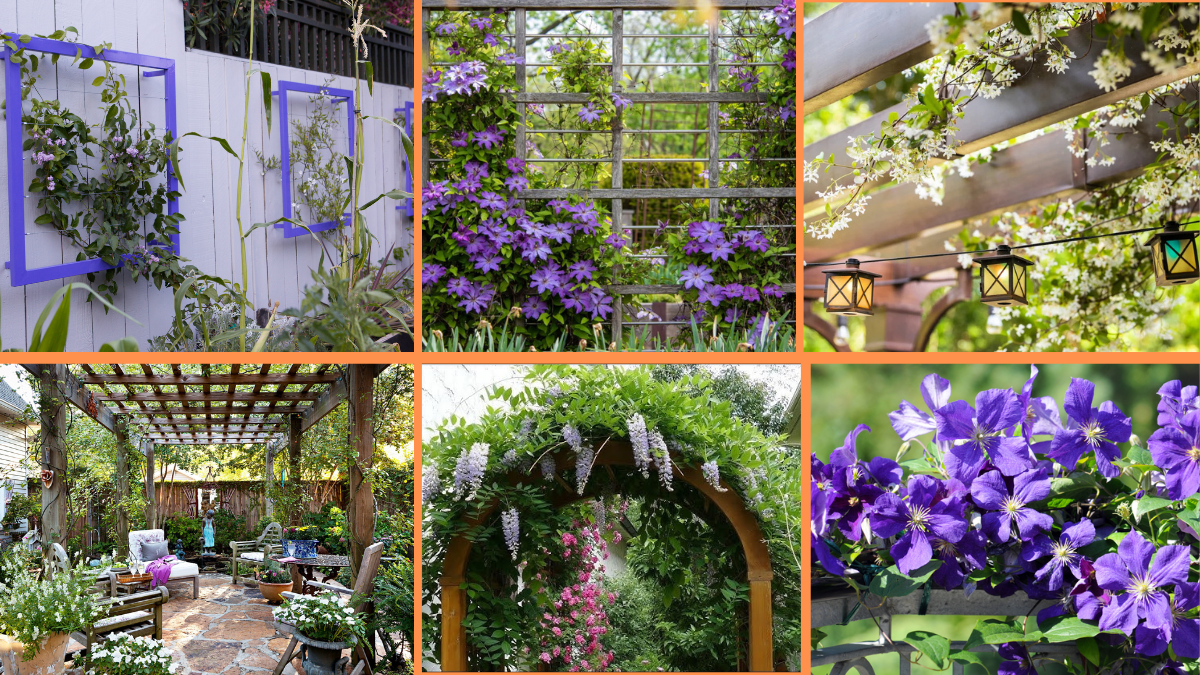A beautifully designed garden isn’t just about flower beds and ground cover — it’s also about making the most of vertical space. Climbing plants and vines are among the most charming and versatile elements in garden design, adding texture, height, and movement to your landscape. Whether you have a small patio or a sprawling backyard, vines can transform ordinary walls, fences, and structures into lush, living masterpieces.
If you’ve ever admired those enchanting pergolas draped with flowering vines or walls covered in a cascade of green leaves, this is your sign to try it yourself. Here are 10 practical and inspiring tips to help you add vertical interest to your garden using vines.

1. Choose the Right Vines for Your Climate and Purpose
Before picking out vines, consider your local climate, sunlight availability, and the effect you want to achieve. Some vines are evergreen, others deciduous; some grow vigorously, while others take their time.
Popular Types of Vines:
- Flowering Vines: Clematis, Wisteria, Bougainvillea, Morning Glory.
- Evergreen Vines: Star Jasmine, English Ivy, Confederate Jasmine.
- Fast-Growing Vines: Virginia Creeper, Trumpet Vine, Sweet Autumn Clematis.
- Edible Vines: Grape vines, Passionfruit, Beans, Cucumbers.
Choose vines that suit your garden’s needs — whether it’s creating shade, adding privacy, covering unsightly walls, or attracting pollinators.

2. Use Vertical Structures Creatively
Vines need something to climb. From trellises to arches, integrating vertical structures allows these plants to grow up and out, adding height and dimension to your landscape.
Ideas for Vertical Supports:
- Trellises: Great for small spaces and patios.
- Arches and Arbors: Create charming entryways or garden transitions.
- Pergolas and Gazebos: Perfect for providing shade with flowering or leafy vines.
- Fences and Walls: Ideal for privacy screens or covering unattractive surfaces.
- Obelisks and Garden Towers: Add a vertical focal point to flower beds.
Select materials that complement your garden’s style — rustic wood, wrought iron, or modern metal frames — and make sure they’re sturdy enough for mature, heavy vines.

3. Plan for Growth and Maintenance
Vines can grow quickly, and some can become invasive or overwhelming if left unchecked. It’s essential to understand the growth habits of your chosen plant and plan regular maintenance.
Growth Habit Considerations:
- Twining Vines: Like Morning Glory or Wisteria, which wrap around supports.
- Clinging Vines: Like Ivy, which use aerial roots or tendrils to grip surfaces.
- Sprawling Vines: Like Bougainvillea, which need to be tied or trained.
Regular pruning, thinning, and guiding new growth ensures the vine stays healthy, looks tidy, and doesn’t damage structures or other plants.

4. Mix Flowering and Foliage Vines
To keep your vertical garden visually interesting year-round, mix flowering vines with foliage-rich climbers. Flowering vines add color and seasonal interest, while evergreen or textured foliage vines provide structure and greenery even in winter.
Great Combinations:
- Clematis (flowers) + Ivy (evergreen foliage).
- Bougainvillea (color) + Confederate Jasmine (fragrance and leaves).
- Passionflower (unique flowers) + Virginia Creeper (vibrant autumn leaves).
Layering different textures and bloom times ensures your vertical space is always alive with something beautiful to look at.

5. Create Privacy Screens with Dense Vines
If you want to shield your garden from neighbors or mask an unattractive view, dense, fast-growing vines can act as natural privacy screens. Install a trellis or lattice panel and let climbing plants do the rest.
Top Privacy Vines:
- Trumpet Vine
- Star Jasmine
- Honeysuckle
- Boston Ivy
These varieties offer quick coverage, some with fragrant blooms, and can turn a bare fence or wall into a green, leafy retreat.

6. Use Vines to Soften Harsh Structures
Harsh concrete walls, metal fences, or stark building facades can be softened beautifully with cascading vines. Plants like Ivy, Creeping Fig, and Climbing Hydrangea can cover large areas, adding natural texture and a sense of tranquility.
Pro Tip:
Ensure the chosen vines won’t damage masonry or structures with aggressive root systems or clinging habits unless the wall is designed to support them.
7. Add Vertical Interest in Containers
You don’t need a large garden to enjoy climbing plants. Vines can thrive in containers, making them perfect for patios, balconies, and small urban spaces.
Container Tips:
- Use tall trellises, obelisks, or wire frames in the pot.
- Choose compact or twining varieties like Sweet Peas, Black-eyed Susan Vine, or Miniature Clematis.
- Ensure the container is large enough for root growth and has proper drainage.
A series of potted climbing plants can create a movable, changeable green wall.
8. Attract Pollinators and Wildlife
Many vines not only beautify your garden but also support local ecosystems by attracting bees, butterflies, hummingbirds, and small birds.
Pollinator-Friendly Vines:
- Honeysuckle
- Passionflower
- Trumpet Vine
- Clematis
These plants provide nectar, shelter, and nesting sites, turning your vertical spaces into a lively hub for beneficial wildlife.
9. Use Edible Vines for Vertical Kitchen Gardens
Vertical gardening isn’t just about aesthetics — it’s also a smart way to grow your own food. Edible vines can produce fresh fruits, vegetables, and herbs while saving space.
Easy Edible Vines:
- Grape Vines (grapes for eating or winemaking)
- Beans (runner and pole varieties)
- Cucumbers
- Passionfruit
- Climbing Tomatoes (indeterminate types)
Train them up trellises, arches, or pergolas for a productive, decorative vertical garden you can harvest from.
10. Experiment with Seasonal and Annual Vines
Not every vine has to be a long-term commitment. Fast-growing annual vines are perfect for adding temporary color and interest, especially for seasonal events, new garden beds, or areas you want to refresh each year.
Top Annual Vines:
- Morning Glory
- Black-eyed Susan Vine
- Cardinal Climber
- Moonflower (blooms in the evening)
These quick climbers fill vertical spaces in a single season, offering bursts of color, fragrance, and charm.
Final Thoughts
Adding vertical interest with vines is a simple yet transformative way to enhance your garden, patio, or balcony. With the right planning, structure, and plant choices, you can turn plain walls and empty corners into lush, living art.
Whether you’re aiming for romantic flowering displays, dense green privacy screens, or edible vertical gardens, climbing plants offer endless possibilities for creative garden design.
So go ahead — pick up a trellis, plant a vine, and let your garden grow up as well as out!





